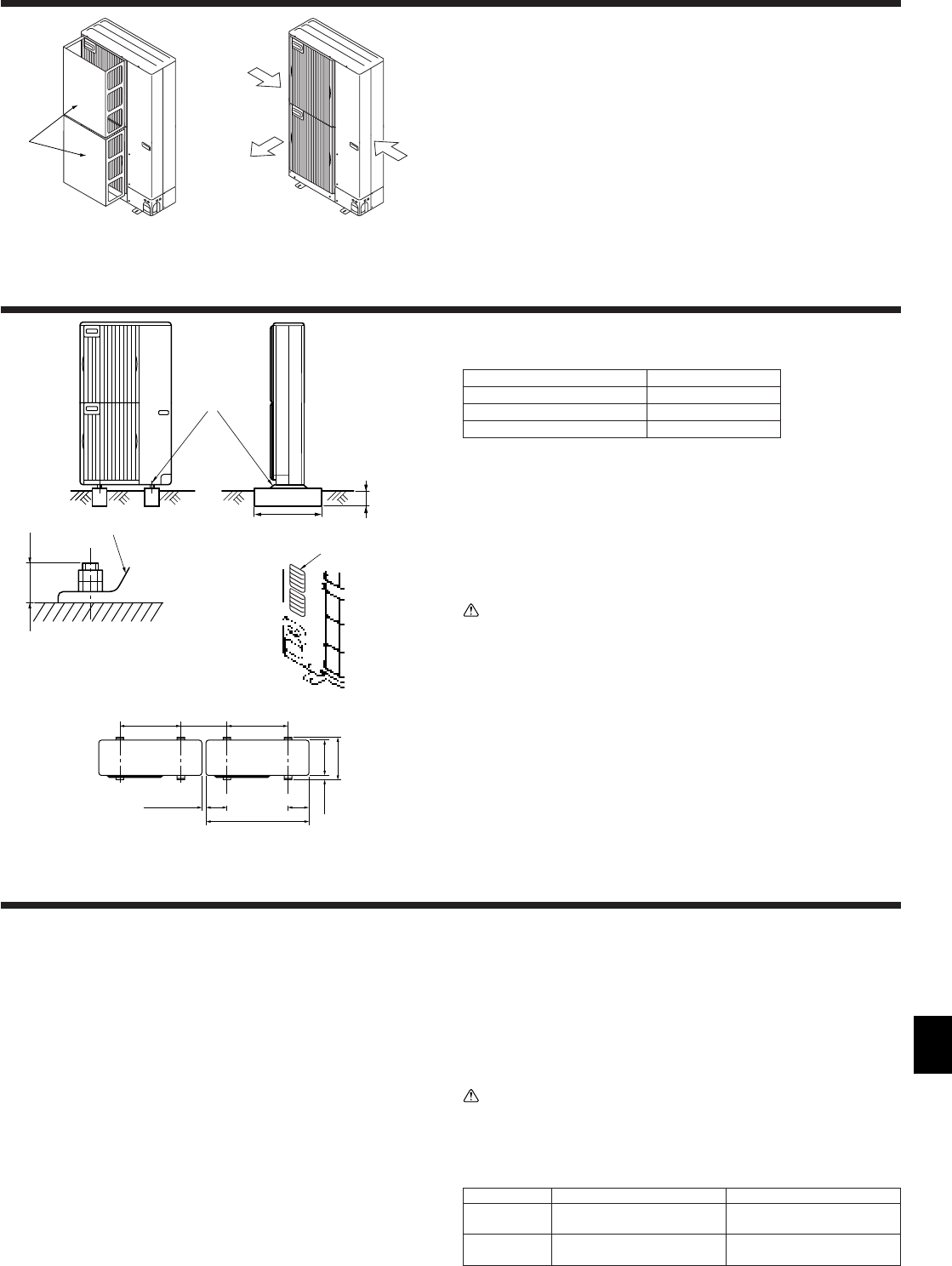
5
B
Max. 1-3/16
2.4.3. Windy location installation
When installing the outdoor unit on a rooftop or other location unprotected from the
wind, situate the air outlet of the unit so that it is not directly exposed to strong winds.
Strong wind entering the air outlet may impede the normal airflow and a malfunction
may result.
The following shows two examples of precautions against strong winds.
1 Install an optional air guide if the unit is installed in a location where strong winds
from a typhoon, etc. may directly enter the air outlet. (Fig. 2-15)
A Air guide
2 Position the unit so that the air outlet blows perpendicularly to the seasonal wind
direction, if possible. (Fig. 2-16)
B Wind direction
Fig. 2-15
B
Fig. 2-16
2. Installation location
3. Installing the outdoor unit
(inch)
• Be sure to install the unit in a sturdy, level surface to prevent rattling noises during
operation. (Fig. 3-1)
<Foundation specifications>
Foundation bolt M10 (3/8")
Thickness of concrete 120 mm [4-23/32 inch]
Length of bolt 70 mm [2-3/4 inch]
Weight-bearing capacity 320 kg [705 lbs]
• Make sure that the length of the foundation bolt is within 30 mm [1-3/16 inch] of the
bottom surface of the base.
• Secure the base of the unit firmly with four-M10 foundation bolts in sturdy locations.
Installing the outdoor unit
• Do not block the vent. If the vent is blocked, operation will be hindered and break-
down may result.
• In addition to the unit base, use the installation holes on the back of the unit to
attach wires, etc., if necessary to install the unit. Use self-tapping screws (ø5 × 15
mm [ø13/16 × 19/32 inch] or less) and install on site.
Warning:
• The unit must be securely installed on a structure that can sustain its weight.
If the unit is mounted on an unstable structure, it may fall down and cause
damage or injuries.
• The unit must be installed according to the instructions in order to minimize
the risk of damage from earthquakes, typhoons, or strong winds. An incor-
rectly installed unit may fall down and cause damage or injuries.
Fig. 3-1
A M10 (3/8") bolt
B Base
C As long as possible.
D Vent
D
4. Installing the refrigerant piping
4.1. Precautions for devices that use R410A refrigerant
• Refer to page 3 for precautions not included below on using air conditioners
with R410A refrigerant.
• Use ester oil, ether oil, alkylbenzene oil (small amount) as the refrigeration oil
applied to the flared sections.
• Use C1220 copper phosphorus, for copper and copper alloy seamless pipes,
to connect the refrigerant pipes. Use refrigerant pipes with the thicknesses
specified in the table to the below. Make sure the insides of the pipes are
clean and do not contain any harmful contaminants such as sulfuric com-
pounds, oxidants, debris, or dust.
Warning:
When installing or moving the air conditioner, use only the specified refriger-
ant (R410A) to charge the refrigerant lines. Do not mix it with any other refriger-
ant and do not allow air to remain in the lines. Air enclosed in the lines can
cause pressure peaks resulting in a rupture and other hazards.
Indoor unit type P06-P18 P24-P54
Liquid pipe
ø6.35 mm [1/4 inch] ø9.52 mm [3/8 inch]
thickness 0.8 mm [1/32 inch] thickness 0.8 mm [1/32 inch]
Gas pipe
ø12.7 mm [1/2 inch] ø15.88 mm [5/8 inch]
thickness 0.8 mm [1/32 inch] thickness 1.0 mm [5/128 inch]
• Do not use pipes thinner than those specified above.
23-5/8 23-5/8Min. 14-6/32
Min. 13/32
37-13/32
63/64
13
14-9/16
6-7/8 6-7/8
A
A
C


















